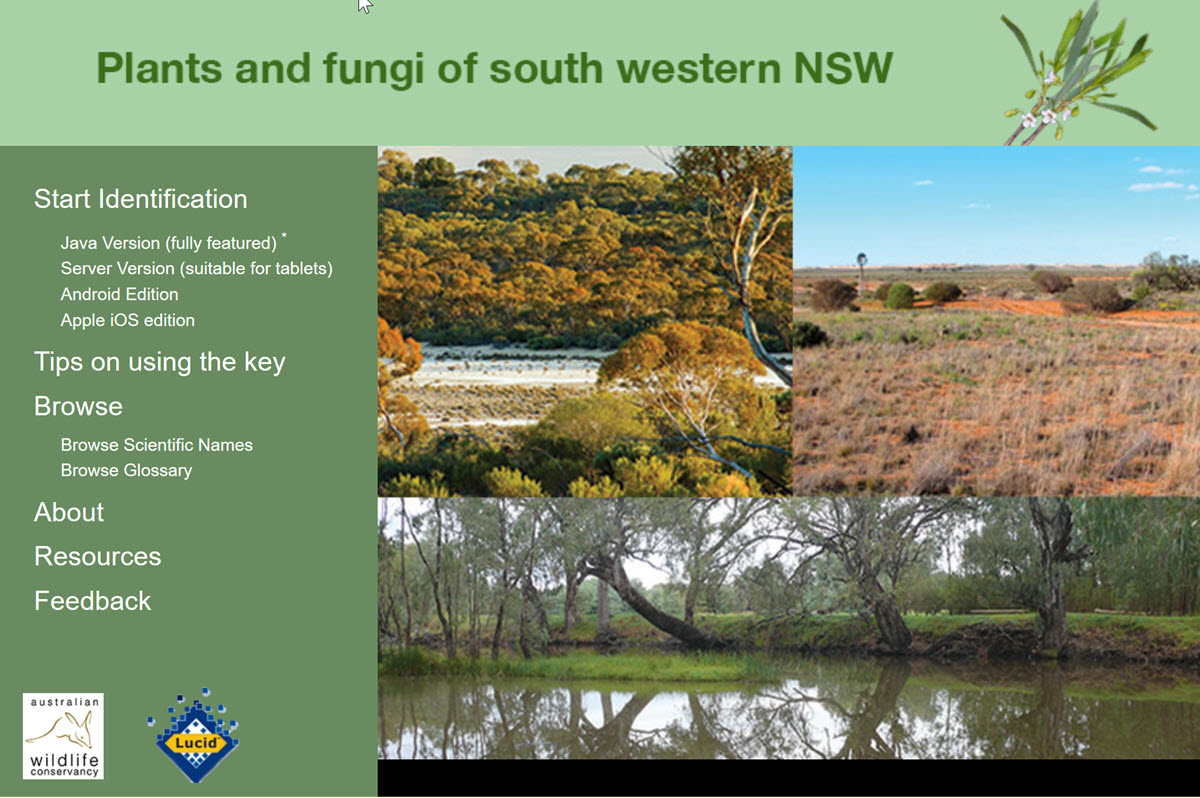 Plants and Fungi of South Western New South Wales
Plants and Fungi of South Western New South Wales
2019
iPhone and Android app, Lucid interactive website
colour photographs for all species
a scientific plant name list

A free app for iPones and Android available on Apple iTunes and Google Play.
You can also access it via computer on the Lucid website.
The Plants and Fungi of South Western New South Wales app describes 1100 plants in South Western NSW and includes a tool to identify plants you may find in this region.
Plants and Fungi of South Western New South Wales key
The key uses a limited number of easily seen characters using a minimum of technical terms to help with identification of plants. It is not designed to key out to a single species, though sometimes it does. It is designed to narrow down the possibilities of what the plant might be to a limited number of species. The photos may then help you decide what your plant is.
In most cases, the use of a hand lens is not necessary for identification. Identification needing the use of even a low power microscope, or a detailed knowledge of technical terms is beyond the scope of the key.
The character ‘ligules’ (for grasses) is the only character in the key that requires a hand lens. A hand lens will also be helpful for other characters e.g. ‘spikelet length’ for grasses with small seeds.
Area covered by the key
The northern boundary of the area covered by the key is a line drawn from 33S 141E to 33S 143.25E, the west boundary is along the South Australian border, the south boundary the northern bank of the Murray River, and the east boundary a line south from 33S 143.25E to the north bank of the Murray River (an area south and west from a few kilometres north and east of Mungo National Park).
Government reserves in the area are: Tarawi Nature Reserve, Mallee Cliffs National Park, Mungo National Park, Mungo State Conservation Area, Nearie Lake Nature Reserve, Euston Regional Park, Kemendok National Park and Kemendok Nature Reserve. Non-government reserves are Scotia Sanctuary (Australian Wildlife Conservancy) and Nanya Station (University of Ballarat).
The Plants and fungi of South Western New South Wales key also covers (in NSW) nearly all of the species recorded from Kinchega National Park, and most of the species from the Murrumbidgee Valley reserves (National Park, Nature Reserve, Regional Park and State Conservation Area) and Willandra National Park, (in SA) most of the species from Danggali Conservation Park and Wilderness Reserve, Calperum Pastoral Lease and Scientific Reserve, Chowilla Game and Regional Reserve, and Birds Australia Gluepot Reserve, (in Vic) most of the species in north west Victoria, which includes the reserves: Murray Sunset National Park, Hattah-Kulkyne and Murray-Kulkyne National Parks, and Annuello Flora and Fauna Reserve.
Plant terminology
The terminology for plant names is that of the Australian Plant Census at as June 2013. In cases where the Council of Heads of Australian Herbaria has not yet made a determination, plant names published in Plantnet are used.
Background to the key
The key was based initially on the set of photos taken at the Australian Wildlife Conservancy property, Scotia Sanctuary, in western NSW, between 2006 and 2012. Additional photos have been sourced mainly from the Internet. For some species recorded in this area, no photographs are available, or photographs are only available by linking to another site on the Internet.
The Scotia Sanctuary Herbarium Project
Don and Betty Wood created a herbarium of pressed specimens with accompanying photographs as volunteers at Scotia Sanctuary, an Australian Wildlife Conservancy property in far western New South Wales, Australia. Other contributors were Anne Evers and Wendy Grimm (volunteers), and Michelle Brown, Tony Cathcart, and Joe Stephens (staff). 336 species were recorded, including 8 species of fungi.
Seventy-four plant species were found planted on Scotia Sanctuary, of which 8 also occurred there naturally. Four planted species were of unknown cultivars.
In almost all cases, duplicate specimens were deposited at the Australian National Herbarium, Canberra. Four specimens were identified by the South Australian Herbarium. Three species (Maireana sedifolia, Maireana trichoptera and Portulaca intraterranea) were not confirmed by either herbarium. Three species (Austrostipa sp., Marsilea sp., and Triglochin sp.) were identified only to genus level and not sent to an herbarium.
One hundred and one additional species not seen during the project are recorded for Scotia Sanctuary.
About the author
Betty Wood, by training a pharmacologist, developed an interest in wildflowers and their identification many years ago when she first settled in Canberra. Her mother-in-law, an English botanist, helped her to learn to use botanical keys to identify Australian plants. She is co-author (with her husband Don) of Flowers of the South Coast & Ranges of New South Wales in three volumes, Flowers of the ACT & Region, and sole author of Simple Guide to Eucalypts and Similar Trees of the South coast and Ranges of NSW (Including the Illawarra and Southern Highlands).
Installation
A free app for iPones and Android available on Apple iTunes and Google Play.
You can also access it via computer on the Lucid website.

